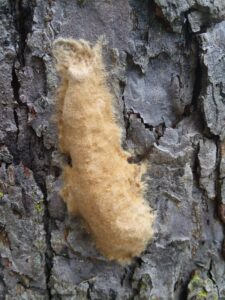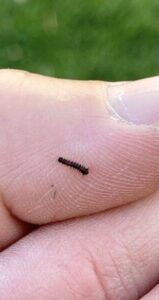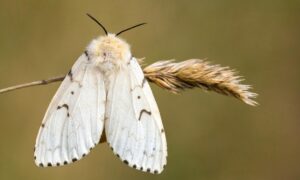Written by: Emily Cheng
This article will detail about the invasive subspecies of European Lymantria Dispar that have left the biggest impact in Southern Ontario. There will also be information on the other two subspecies and their most commonly targeted species of trees.
Recently, the Entomological Society of America which oversees common bug names announced that it will be discarding the use of the common name “Gypsy Moth” because it was an ethnic slur and offensive. The name “Gypsy Moth” likely stemmed from the small balloon-like air pockets in the caterpillar’s hairs which allowed them to float for miles and wander around like the rejected gypsies in Romania. For now, a new common name has not been chosen by the organization so the species will instead be referred to as L. Dispar throughout the article.
There are three total subspecies of L. Dispar; the “Lymantria Dispar Dispar”, “Lymantria dispar Asiatica”, and “Lymantria Dispar Japonica”. Lymantria Dispar Dispar feeds on a wide range of hardwood and some softwood trees and is native to Europe, North Africa, and Asia. The subspecies “Lymantria Dispar Asiatica” originates in Eastern Asia and mainly feeds on Siberian Larch trees. “Lymantria Dispar Japonica” originates in Japan and its caterpillars prefer larger trees. The L. Dispar in Southern Ontario were brought over from Europe so they are not native to North America.
All subspecies of L. Dispar are equally as destructive. They feed on the foliage of over 300 different plant species, making the results very disastrous for the biodiversity of the environment. Since one egg mass contains 100-1000 eggs and considering that a caterpillar can eat an average of 1m2 of leaves over its lifetime, there could be thousands of square metres of leaf canopies lost in only one season. Repeated defoliation would result in trees that are more vulnerable to pests and diseases, and years of continuous leaf loss can lead to tree death.
So how was this non-native species introduced to Southern Ontario in the first place? A French artist and naturalist named Étienne Léo-pold Trouvelot first imported L.D Dispar* from Europe around 1868-1869 because he wanted to explore the options of silk production by native moth species. Unfortunately, he didn’t realize the consequences of his actions at the time and that the invasive species would eventually escape and completely strip hundreds of square miles of trees in Boston and Northeastern US over the next few decades. In 1969, the L.D Dispar had spread to Ontario, and to this day their population surges every 7-10 years before dropping due to
competition for resources or from a host-specific virus or fungus. In Ontario, the peaks in major outbreaks have been recorded in 1985, 1991, 2002, and 2008, as well as the most recent in 2019 and 2021. Favoured tree species at the most risk are oak, maple, birch, white pine, and white spruce.
To help control the spread of L.D Dispar, it is important to identify and understand how to manage them during each part of their life cycle.
It takes one year to complete the life cycle, starting with the tan-coloured furry egg masses that are laid from around July-April (Some sources list as early as May and others as far back as August). You can typically find them almost glued onto tree trunks, bark, or other hard surfaces like lawn equipment. To remove the eggs, you would need to use a scraper to carefully scrape off and dispose of them in soap and water mixtures.

I faintly remember seeing these same egg masses over a year ago while on a hike and accidentally shrugging it off as weird tree moss.
Dispar eggs hatch in early to mid-spring. Below is an image of a caterpillar that had recently emerged from its egg.

Tiny! A lot of them kept dropping out of nowhere onto my balcony this year.
These caterpillars are the ones that cause mass tree defoliation and can be identified by their charcoal gray colour with several double pair blue and red tubercles (dots) on their back. They also have long and thin hairs spiking out of each side which need to be handled with care – as it can cause skin irritation or allergic reactions in some people.

There are exactly 6 pairs of red dots and 5 pairs of blue dots on almost every caterpillar. Sometimes they can be all black or blue.
Occasionally the province does public aerial sprays over regions that have moderate to severe infestations. To manage individual trees in your property, you can set up burlap traps by wrapping a 45cm wide strip around the tree at chest height and tying a string around the centre and folding the top portion down to form a skirt. The caterpillars would come down the tree
during the day to hide underneath the burlap and you would need to check the tree in the evening to pick the caterpillars and drop them in a bucket of soapy water. You can also stick a wide strip of tape around the chest of the tree to hopefully stick the caterpillars and prevent them from reaching the top of the tree in the first place. All of these steps are uncomfortable but it is a necessary step that will help regulate the population long term and protect the other trees in your area from becoming infested as well.
The caterpillars shed their skin several times before finding a sheltered location to pupate. This is the stage where they create cocoons and transform from caterpillars to moths.
These can usually be found on trees, hanging from a branch or on a leaf.
The moths emerge from their cocoons in early August and do not eat for the last week of their lifespan. At the final stage, the adult female moths are flightless and have white colouring and dark zig-zag markings.

An adult female moth
The males are greyish-brown with dark markings and can fly around to mate with several different females.

This year, there were so many moths flying around our neighbourhood that you would see one every few minutes!
There isn’t much that can be done to control the population of the adult moths but you can still help by being able to identify and report sightings on the Canadian Invasive Species Centre website. Working together, we can all help manage the population and control the spread of this invasive species.
For more information on prominent invasive species in our area, the article “3 Invasive Species to Look Out For in Southern Ontario” is a good guide to learn more about a larger range of invasive plants and insects.
*The European subspecies of “L. Dispar” is named “L. Dispar Dispar”, thus the shortened form “L.D Dispar”.
Images used:
https://butterfly-conservation.org/moths/gypsy-moth
Links used for further research:
https://www.invasivespeciescentre.ca/wp-content/uploads/2020/08/european-gypsy-moth-fact-sheet.pdf
https://www.severnsound.ca/Shared%20Documents/Info/SSEA_GypsyMoth_FactSheet_update_2021.pdf
https://www.cbc.ca/news/canada/windsor/windsor-sarnia-lambton-shores-gypsy-moths-1.6037086
https://www.gov.mb.ca/forest/pubs/forest_lands/health/gypsy_moth.pdf
A really good scientifically detailed book about the L. Dispar:
https://www.fs.fed.us/foresthealth/technology/pdfs/Pogue_Lymantria_web.pdf

